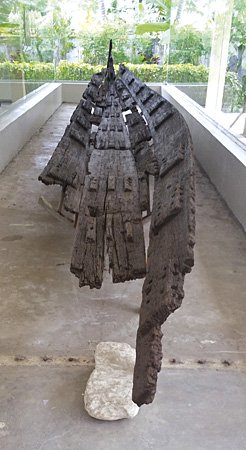Cultural Center of the Philippines
ENCYCLOPEDIA OF
PHILIPPINE ART
[Balanghai CE 320]
Wooden planks, cordage made from cabo negro (Arenga pinnata) / Length 15 m, width 2.8 m, midship draft 1.1 m, 1.5 with stand / Ambangan, Libertad, Butuan, Agusan del Norte Province, northeastern Mindanao, Philippines / NMP X-77-U-127 / National Museum of the Philippines collection
On the east bank of the Masao River in the Ambangan hamlet of Libertad, Butuan City, Agusan del Norte Province in northeastern Mindanao lies a waterlogged archaeological site that the National Museum began excavating in 1976 after a steady emergence of fine Asian tradeware in Manila’s antique market. During a decade of work, archaeologists located 11 boats and subjected three to C14 dating. Recovered in 1978, the first boat generated a date of CE 320; soon after, a second yielded the date CE 1250; and in 1986, a third yielded the date CE 990. Because of the high costs involved in analysis, the team left five prehistoric boats in anaerobic (in mud) condition. The balanghai (boat) hull under discussion, the oldest, is now on display in the Balanghay Shrine in Libertad, Butuan City.
The wooden planks of this boat’s hull measure 15 m in length and 2.8 m across the beam; the dimensions are similar to other boats in Southeast Asia that bear the edge-pegged method of construction. The locals call the hardwood used for the planks dongon (Heretiera sp.), each carved into one continuous piece. The hardwood pegs or dowels were made from a mangrove wood species (Rhizophora sp.). From plank to plank and from plank to keel, the pegs were embedded in 12 cm intervals. Measuring 19 cm long, the pegs were driven into holes in the middle of the edge of each board.
Butuan was a major trading port from the 10th to the 12th century. Butuanons collected sea products, like pearls, mother-of-pearls, tortoise shells, and sea cucumbers (tripang or Holothuria sp.), and forest products, like medicinal and aromatic products, beeswax, resin, and camphor, which they exchanged for foreign goods. They were also major manufacturers of goods like pottery, textiles, mats, gold ornaments, metal tools (lead, iron, bronze), and reworked glass beads that they marketed to the hinterlands. They traded staples (banana, root crops, sago), dried fish, fish paste, salt, and rice, as well as slaves. Butuan began to decline in the 12th century as Muslim traders increasingly dominated the region and settled in the Sulu archipelago in the 14th century. While the earliest Asian tradeware from Butuan comes from the Five Dynasties period (CE 907-960), the 320 BCE date given the earliest balanghai gives credence to long-distance trade prior to contact with the great traditions of India and China. Moreover, that prehistoric Southeast Asians today share boatbuilding methods with peoples like the Sama of the Sulu Archipelago, points to a long-standing and shared heritage of seamanship, commerce, and social interaction in population centers that began in the Metal Age (500 BCE to CE 1000) and persists today.
Written by Purissima Benitez-Johannot
Sources
Cembrano, Margarita R. 1989. “Guangdong Song Dynasty Sherds Discovered at the Balangay Area, Butuan, Northeastern Mindanao.” In Guangdong Ceramics from Butuan and Other Philippine Sites, edited by Roxana Brown, 71-79. Manila: Oriental Ceramic Society of the Philippines.
Reid, Anthony. 1990. Land Below the Winds. Vol. 1, Southeast Asia in the Age of Commerce 1450-1680. Yale University Press.
Ronquillo, Wilfredo P. 1989. “The Butuan Archaeological Sites: Profound Implications for Philippines and Southeast Asian Prehistory.” In Guangdong Ceramics from Butuan and Other Philippine Sites, edited by Roxanna M. Brown, 61-69. Manila: Oriental Ceramic Society of the Philippines.
———. 2011c. “Wooden Hull of a Boat.” In Paths of Origins: The Austronesian Heritage from the National Museum of the Philippines, the Museum Nasional Indonesia, and the Rijksmuseum voor Volkenkunde, edited by Purissima Benitez-Johannot, 138-39. Singapore: ArtPostAsia.
